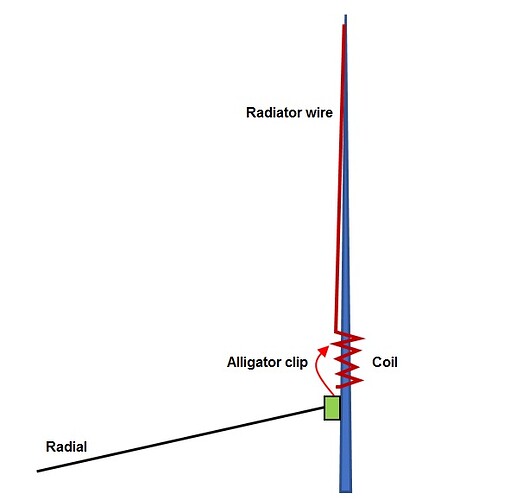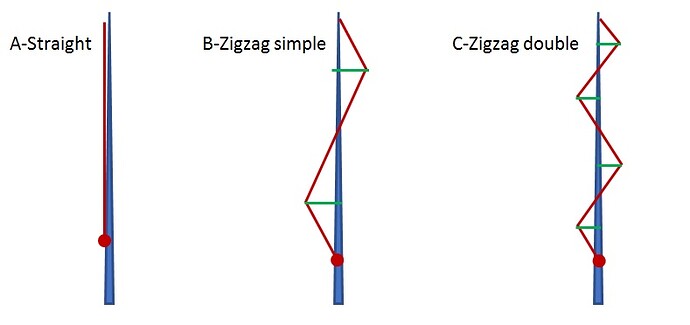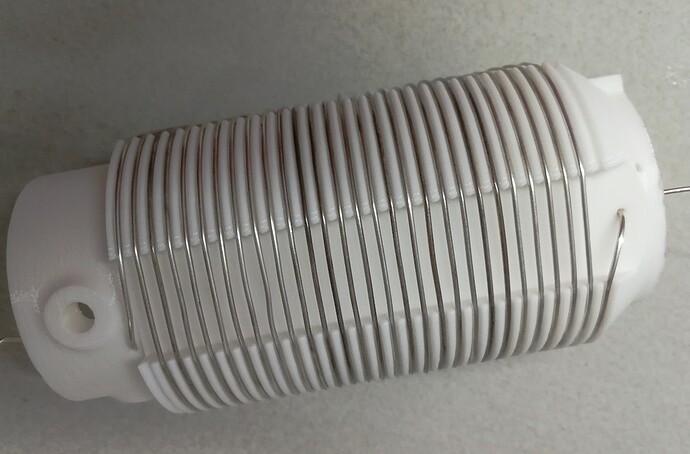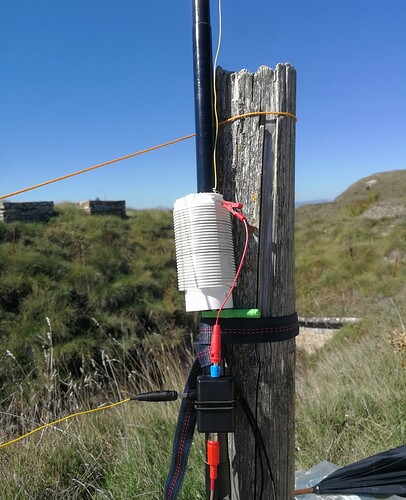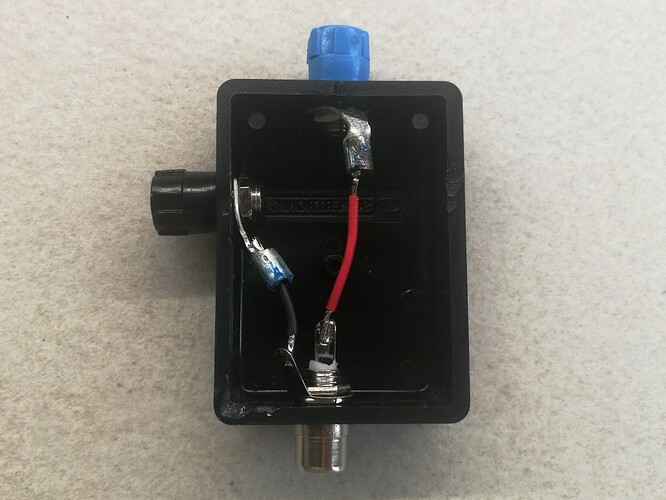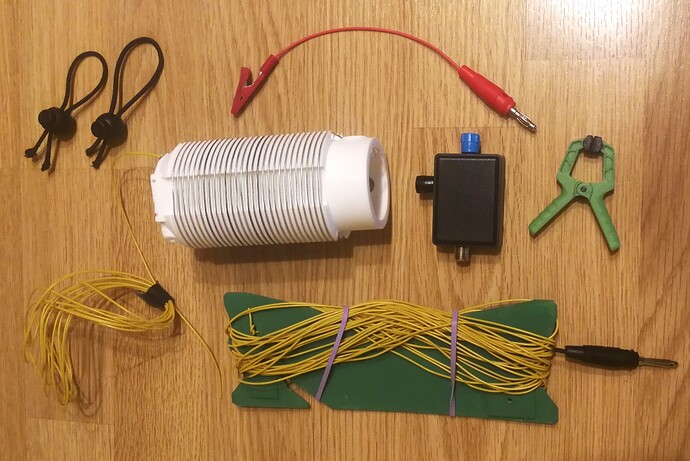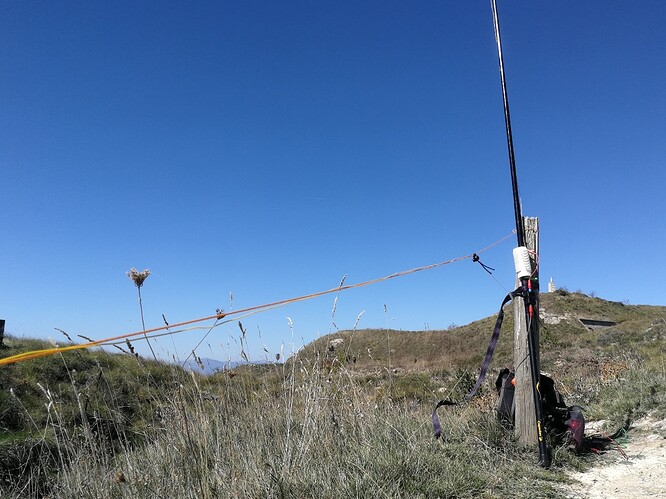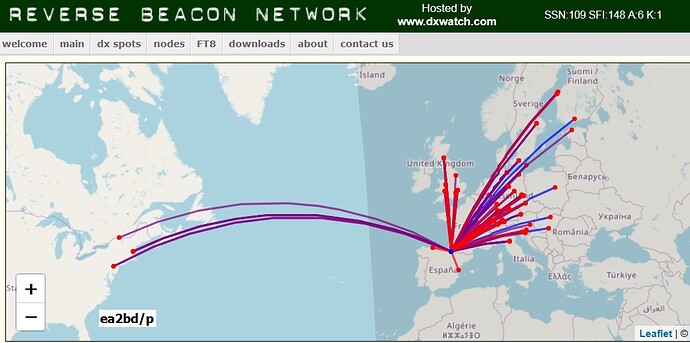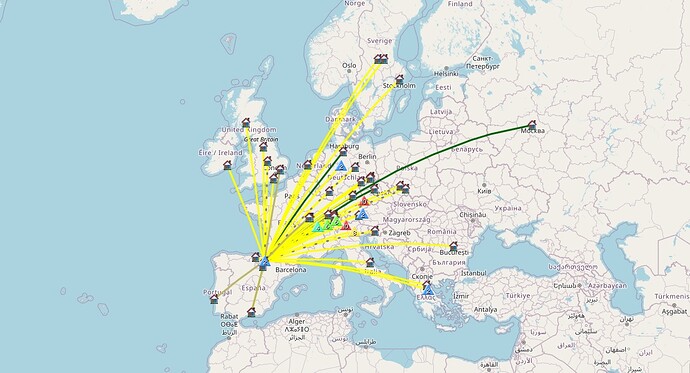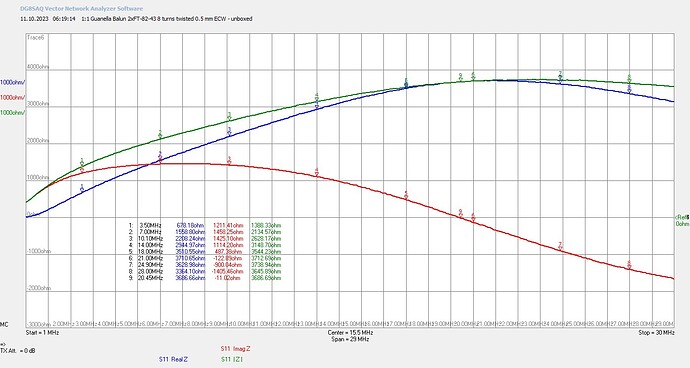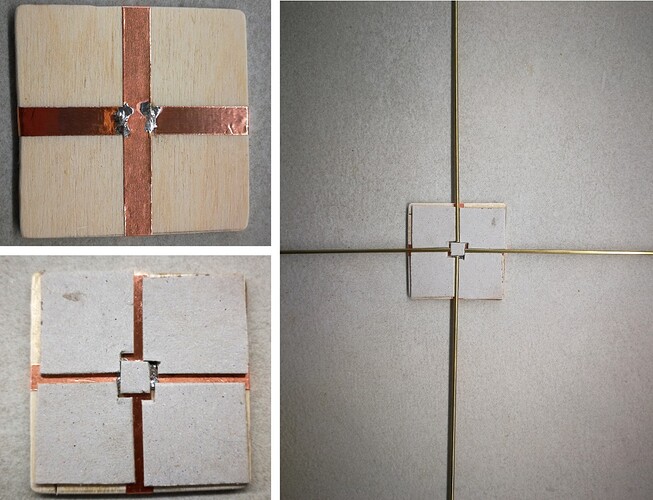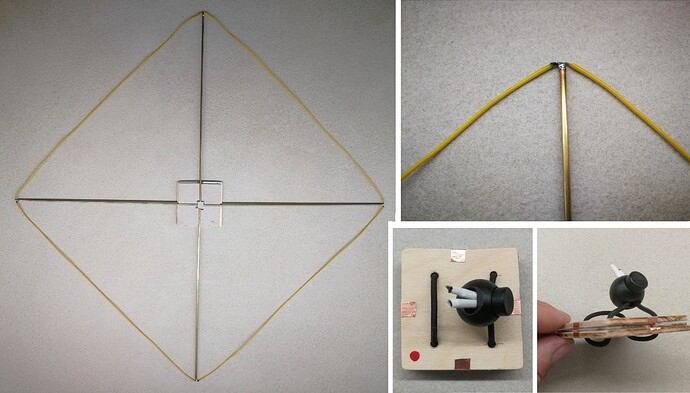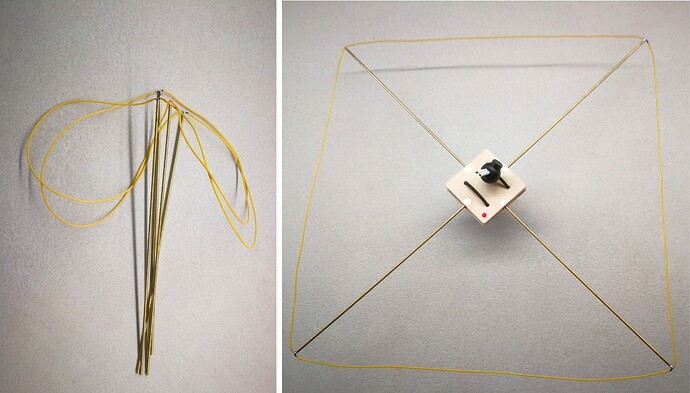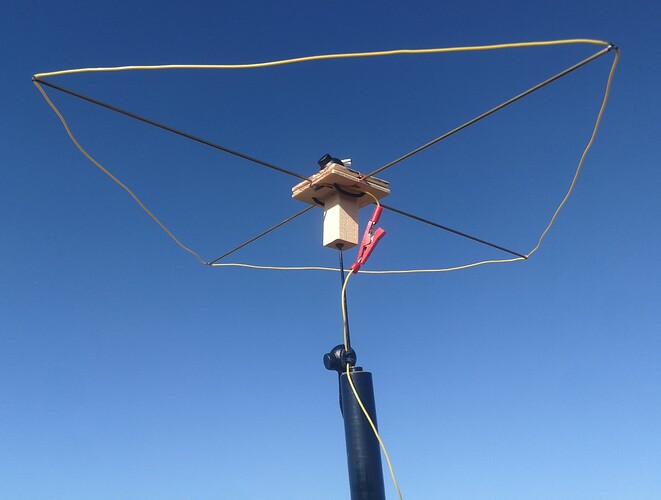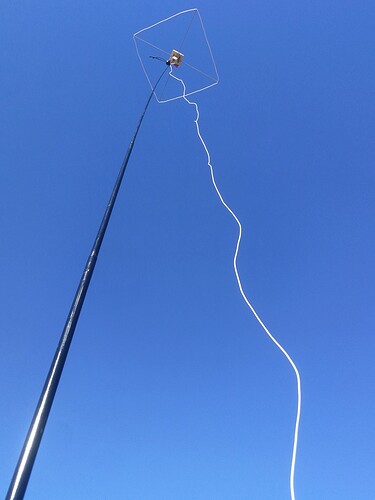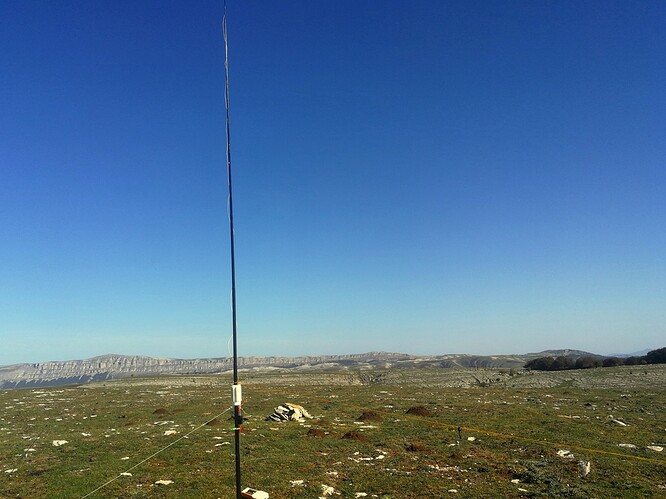Yes another antenna for my backpack!
Motivation
When on the field, I have been using a variety of antennas along the years. Nowadays I use a multiband EFHW 90% of my activations. Performance and repeatability of results, based on number of QSO, makes this aerial a keeper.
Nevertheless, every now and then I have issues in certain summits to deploy my EFHW, even my shorter loaded version (14m long). This happens in crowded with vegetation summits where branches from trees reduce the free space. Alternatively summits with a very reduced flat area are also problematic.
For such kind of summits I decided to prepare a short vertical that I could install easily.
Design
There are some vertical antennas ready made by manufacturers, like the Buddistick, PAC-12, AX1/AX2 or some other whip antennas. Most of them have a reduced length radiator plus certain ground system and are put to resonance by means of a coil somewhere.
Performance, as expected, is reduced. The shorter the radial, the more reduced its performance. Radiation pattern has also to be considered for a vertical antenna: it doesn’t produce an NVIS radiation.
A short vertical has a reduced radiation resistance, and there are some ground losses associated to the radials. Both effects influence on the resulting impedance, usually less than the desirable 50 ohm.
It’s possible that you see a good SWR level in your rig with a short vertical, but the truth is that you are probably losing RF due to the short radiator length, you get losses in the coil (heat) and in the poor ground system used (too little number of radials) and therefore the true radiated power is not 5w but less. In the other hand, strength of the received signals are also lower producing difficulties with the weak ones.
Bearing all this background in mind I decided to give a vertical a try, focusing on these targets:
- Use a short vertical wire instead of a telescopic whip.
- Limit the size of the pole to a 4 meter long, as I don’t want it too tall.
- Elevate the feed point around 1 meter over ground.
- Add a tunable homebrew coil.
- Use a single radial elevated over ground. This reduces the required wire and adds certain directivity towards the radial direction.
- Cover several HF bands: 10-14-18-21 MHz. 7 Mhz would be desirable but I’m conscious its performance would be marginal.
Although placing the coil in the center of the radiator increases the radiation compared to the base loaded version, due to the fact this antenna will be used for portable, on an uncontrolled variety of soil, I decided to finally put the coil just down, at the feedpoint so that I could tune the coil with ease, setting the inductance by means of an alligator clip.
This scheme gives a basic idea of the design:
Evaluation of Radiator length variants
According to my constraints, the wire length should be 3 meters. This is already an improvement compared to some other shorter whip antennas (Elecraft AX1 / AX2 in example are 1,15 m long).
Nevertheless, I considered alternatives to enlarge the wire length without changing the size of my pole, that is 4 meter long, and my elevated feed point kept at one meter over ground.
One solution I simulated is to put a wire zigzagging the pole, like this:
I measured the resulting wire length of such scenarios and, using horizontal spreaders of 40 cm (green arms on the scheme), the achieved lengths for either design were:
The length increase is little on the Zigzag simple version but considerable for the Zigzag double.
Does it worth preparing this increased length version?
Bearing in mind that I want this antenna for restricted spaces, the zigzagged versions would probably require additional setup time on a summit to properly deploy it and could suffer from a potential interference from branches and vegetation. Installation would be time consuming and probably annoying, putting on risk the success of the radio activation.
Therefore, I decided it wouldn’t worth the effort to extend the length so I better use a straight wire instead. It’s better to keep the design simple although this evaluation was a good exercise to look for such alternatives.
The coil
My friend Mique, EA2EUS, was kind to provide me with a 3D printed coil former. He printed the SA2CLC coil former, available in thingverse web:
https://www.thingiverse.com/thing:4525375
This former is a bit oversized for a QRP antenna, but it is robust and will resist many activation in the mountain without being damaged.
Main dimensions:
- Diameter: 62 mm
- Coil height: 83 mm / Full height: 121 mm (after cutting off a part I didn’t need)
- Coil turns: 28
I easily winded a solid conductor of 1 mm diameter. Using my LC meter I measured around 26 uHenry. It looks a good coil for the job. The separation between turns allow using an alligator clip to tune it. See how it looks assembled in the field:
The radial
I cut a bit over 10 meter of lightweight antenna wire from Sotabeams (yellow cable). This is a 7/0,2 mm (0,22 mm2), approx. 24 AWG size, with PVC insulation and 0,92 velocity factor.
Then I prepared a cardboard wire winder. I did it very simple and protected with acrylic paint. It’s not the best solution but was easy to design and I could go out for a field test.
The connector box is very simple, and perhaps I will fit a toroid choke on it.
The whole system (except the pole) weights 254 gram, not heavy!
This is the complete antenna ready for evaluation:
Testing the antenna
I tried the antenna on EA2/NV-119. It is not a restricted summit but wanted to check how the antenna was performing. Activation date: Sept-29th 2023.
Set up was very easy and fast. I tied my pole to a stick, extended the antenna up, placed the coil, and added a small box for the connector and the radial, extending it towards Europe.
The radial wasn’t elevated all its length but sloped. I put a long cord so that I could hang the radial on it and extend or reduce the radial using the winder, depending on the band of choice. The far end was around 15 cm over ground.
I decided to run on 18 MHz CW first. Tuning was easy looking to the maximun noise with the clip on the coil. Later I ran on 14 MHz and finally on 10 MHz.
See the RBN spots I got per band:
I had a few qso on 18 MHz with some DX, and moved to 14 MHZ whereI had a good feeling with the usual stream of chasers, great.
I spent a few minutes for the final part on 10 MHz: there felt the band was less live, perhaps a reduced RX as expected due to the short wire length for this band?
After 1h 30 min activation I closed my log with 53 being 12 S2S. I was happy with the result .
See how the RBN Spots map agrees with the resulting QSO map:
Future development
- Other bands
I tried to tune the antenna on 21 MHz without success, SWR was 5,5 at best. Is perhaps the wire too long for the band? That is pending to check.
I couldn’t tune the coil for 7 MHz either. Minimum resonace at maximum load of the coil was 8 MHz. Although the performance in 7 MHz would be presumably very low, I should add more inductance (an additional coil in series) or perhaps trying a capacitive hat on top. That is pending to check too.
- RF common mode
During thee activation I saw variations of SWR at times while transmitting.
I tried measuring SWR and impedance on a park another day and experienced difficulties to read stable values in my antenna analyzer. The Z was changing up and down. My feeling was there is RF flowing through the coaxial. Perhaps I will add a FT82-43 choke at the connector box to see if this cures the issue.
I must run a real test on a restricted summit in the future to confirm these satisfactory preliminar results.
73 Ignacio
